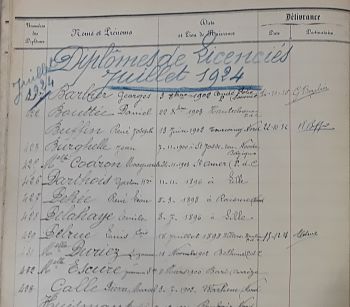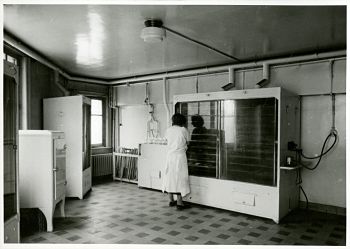
Childhood and education
Marguerite Marie Louise Codron was born in Saint-Omer on 24 November 1903. Her father, Alfred Codron, was a postal and telegraph clerk, and her mother, Denise Flore Ernestine Lenclos, did not appear to have a profession.
During the First World War, the ‘bulletin des réfugiés du Nord’ listed repatriated civilians. In 1915, a ‘Codron (Marguerite) from Lille’ appeared on this list. While it is possible that she was evacuated during this period, gaps in the documentation do not allow us to confirm or refute this hypothesis.
Her student file at the Lille Faculty of Science has not been found, so it is difficult to obtain information about her childhood and secondary education, apart from the fact that she obtained her baccalauréat in July 1922. However, she did go on to higher education and obtained a Bachelor of Science, while her sister Louise (Flore, Zénaïde) Codron[1] obtained a Bachelor of Arts.
At that time, it was necessary to obtain at least three certificates of higher education in different specialities. Between November 1923 and June 1924, Marguerite Codron obtained four certificates of higher education in the following disciplines: General Physics, General Chemistry, General Mathematics and the certificate in Physical, Chemical and Natural Sciences.This enabled her to obtain her Bachelor of Science degree in July 1924. She went on to study for a certificate in mineralogy, which she obtained in 1925.
From chemistry ‘assistante’ to acting director of the Institute for Seed Testing and Agricultural Research: the impact of the Second World War
She married Robert Poix on 10 September 1927. He was a ‘professeur agrégé’ (associate professor) of mathematics at Lycée Faidherbe, before being appointed to the École normale in Armentières. In 1927, Marguerite Codron was declared as having no occupation.The following year, she was appointed deputy chemistry ‘assistante’ (junior member of the faculty’s teaching staff) at the Lille Faculty of Science. In 1930, her career took a new turn as she became a tenured ‘assistante’.
From 1935 onwards, she appears to have joined the teams at the Botany Laboratory, working alongside Maurice Hocquette, at that time ‘maître de conférences’ (senior lecturer) and Director of the Institut d’essais de semence et de recherches agricoles (Institute for Seed Testing and Agricultural Research). This institute was originally the Station d’essais de semences et de recherches (Seed Testing and Research Station), which was created in 1921 thanks to a grant from the regional authorities and annexed to the Botany Laboratory. On 22 March 1929, the ministry recognised the services rendered to farmers by the seed testing station. The scope of its activities expanded, and with this came the creation of the Institute for Seed Testing and Research.
From 1936 onwards, Marguerite Codron-Poix was involved in plant biology and agricultural research, focusing in particular on hops. From 1937 onwards, she published a number of articles on this research, including Contributions à la sélection des houblons en Flandres (Contributions to the Selection of Hops in Flanders). These studies were carried out at the request of brewers; chemical analysis of hybrid hops in the laboratory and at the experimental hops farm at Steenvoorde aimed to determine the best hybrid for cultivation in Flanders. The research carried out by Marguerite Codron-Poix and the laboratory team lasted until the Second World War, when she was given greater responsibility. In the absence of director Maurice Hocquette, she was appointed interim director of the Institut d’essais de semences et de recherches agricoles for the 1940-1941 academic year, then deputy director in 1941.
During the war and under her direction, the analysis and research laboratories of the Institut d’essais de semences et de recherches agricoles continued to operate, and were strongly encouraged by farmers and industrialists in the Nord region. However, due to staff shortages and the increased workload imposed on existing personnel, less scientific research was being conducted in the laboratories.
In 1943, Maurice Hocquette took over as director of the Institute and Marguerite Codron-Poix resumed her activities as ‘assistante’ (junior member of the faculty’s teaching staff) and researcher. She also had administrative duties, being appointed ‘régisseur’ in 1944, which put her in charge of paying petty expenses at the General Botany Laboratory. She was still involved in agricultural botanical research, including microchemical and cytological studies on the secretion of Salvia Splendens (Red Sage). In 1947, Marguerite Codron-Poix began working with a team of researchers to study the consequences of the seawater flooding of maritime Flanders in 1944-1945. To do this, they carry out various analyses on samples of flooded land, to understand the mechanisms of degradation and regeneration of soil structure. She worked on this subject until 1954. At the same time, she supervised students by directing practical work inphysics, chemistry and biology as well as general laboratory chemistry.
The post-war years: an essential ‘assistante’ in the botany laboratory
In 1954, together with Professor André Lebègue and his team, Marguerite Codron-Poix began studies on plant embryology. This enabled her to publish two articles, independently and in collaboration with others, in the Bulletin de la Société Botanique de France in 1955 and 1956: ‘Observations on the Embryonic Development of Epilobium parviflorum’ and ’‘Embryonic Development of Urtica tirens L.’. In 1957, she asked to be put on the list of suitable candidates for the position of ‘chef de travaux’ (senior researcher). This request was met with ‘a favourable opinion, but nothing more’ from Dean Henri Lefebvre. The latter felt that her research activities were greatly reduced. He acknowledged that she was perfectly competent in her position in terms of preparing and supervising practical work, administrative tasks and the smooth running of the laboratory, and that she remained a valuable technical assistant to Professor André Lebègue and his colleagues. But as a practical leader, he wanted to see someone who could make a greater contribution to the department’s scientific activities and who could lead a team of young researchers. It seems that her application was unsuccessful, as she was still an ‘assistante’ (junior member of the faculty’s teaching staff) when she retired in 1964.
The Second World War was an important period in the careers of several women, including Marguerite Codron-Poix. Between 1928 and 1951, she was promoted several times until reaching the status of 1st class ‘assistante’, before being reclassified to the 6th tier in 1961. She was also appointed Officier d’académie in 1939 and Officier de l'instruction publique in 1946. Marguerite Codron-Poix left her mark on the Institut des Semences et Recherches Agricoles, becoming its first female director between 1940 and 1943. She died in 1996 after an exemplary career.
Notes written by Marjorie Desbordes and Marie Lefèvre.
Notes
[1] Louise, Flore, Zénaïde Codron (22/07/1901-30/08/1993) was the sister of Marguerite Codron. She obtained her baccalauréat in 1919 and continued her higher education at the Faculty of Arts, graduating with a Bachelor in Arts in 1926. She continued her studies, passing the agrégation competitive teaching exam in 1933. She was an English teacher in Tourcoing in 1926, and in Maubeuge and Armentières in 1928. During her career, she held a number of positions in different parts of the Nord region. She ended her teaching career at the Lycée Fénelon in Lille. She had been an active member of the National Secondary Education Union (syndicat national de l’enseignement secondaire) since December 1944. She was a member of the Executive Committee until 1949. At the same time, she was also an alternate member of the Secondary Education Council (conseil de l’enseignement du second degré). She retired in 1966.
Bibliography
Lebègue André & Poix Robert (Mme), ‘Le développement embryonnaire chez l’Urtica tirens L.’, Bulletin de la Société Botanique de France, 1956, 103, pp. 587-589. Poix Robert (Mme), ‘Observations sur le développement embryonnaire de l’Epilobium parviflorum Schreb’, Bulletin de la Société Botanique de France, 1955, 102, 5-6, pp. 232-234. maitron.fr/spip.php, notice CODRON Louise, Flore, Zénaïde par Alain Dalançon, Jacques Girault, version uploaded 6 July 2017, last modified 6 July 2017 Bouriquet Robert, Histoire de la Faculté des Sciences de Lille et de l'Université des Sciences et Technologies de Lille, Vol. 5: Histoire de la Botanique à la Faculté des Sciences (1856 - 1970), Association de Solidarité des Anciens Personnels de l’Université de Lille, p. 15 asap.univ-lille.fr/ASAP/publications/Tome5_botanique_maige.pdf
Sources
Nord Department Archives
Lille Faculty of Science Graduate Register - 3268W82 3268W83
Lille Faculty of Science personnel file - 3631W3
Marriage certificate - 3E15311
Pas-de-Calais Department Archives
Birth certificate - 3E765/458
Lille University Library
University of Lille Annals: Annual report of the University Council, Minutes of the Deans of the Faculties, 1909-1965, available online at nordnum.univ-lille.fr/ark:/72505/a011478698385yctcuu
gallica.bnf.fr/National Library of France
Digitised press and magazines: Bulletin des réfugiés du Nord, issue of 24 July 1915, gallica.bnf.fr/ark:/12148/bpt6k62951462



